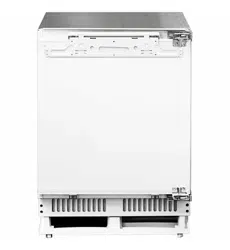Loading ...
Loading ...
Loading ...

16
Thermostat
INSTRUCTIONS
Cold storage is for short-term food
Storage or for daily consumption.
Although the temperature in most parts of the cold storage compartment can
be regulated between 0 and 10 degrees Centigrade, extended periods of food
storage is not recommended. Cold storage should only be used for short-term
storage.
Cold storage compartment
1. Eggs and butter
2. Beverages and bottled drink
3. Food to be frozen
4. General food, meat, vegitables, etc.
Cautions for cold storage
* Hot food must be cooled to room temperature before storing in the
refrigerator
* Dry any water droplets on the food before placing it in the refrigerator.
* It is recommended that food be sealed in suitable storage bags before being
placed in the refrigerator; this will prevent moisture in the food from
evaporating and prevent vegetables and fruit from withering or altering in
flavor.
* Do not store excess quantities or weights of food; food should be stored
with spaces in between for better storage results. Never overload shelves, as
the may collapse under excessive loads.
* Food to be stored should be sorted according to consumer requirements.
Food consumed daily should be placed in the most convenient area, this will
minimize opening periods for the door. Do not place food to close to the
internal walls.
Food holder cleaning
* Food holders can be taken out for cleaning
Lamp & Replacement:
Lamp: 240V, 10W
Lamp holder: E14 (lamps exceeding 15W
must not be used)
* For replacement, unplug to disconnect the
Power
* Remove the lamp by turning anti-clockwise
Instructions for food storage
* Storage period will be extended if vegetables are placed with their roots
towards the cold source.
*Leaves of carrots of turnips should be removed before storage
* Put a wad of tissue on the bottle holder before placing bottles on it so that
later cleaning is easier
* Frozen food can be placed in the cold compartment before serving, as this
will conserve energy.
* Onions, garlic, ginger, water chestnuts and other root vegetables should not
be stored in the refrigerator, as these foods are suitable for long-term storage
at normal temperatures.
* Ripe squash, melon, papaw, bananas and pineapples should not be stored in
the refrigerator. Freezing will accelerate the ripening process.
Long-term storage of food
As the freezer storage temperature is very low, fresh food can be stored in
the freezer compartment for a long time. Food requiring long-term can be
stored in the frozen food compartment. Attention should be paid to the
storage information printed on the food packing.
Frozen food storage
* The recommend weight of fresh food is less than 2 kg.
* Hot food should not be stored in the refrigerator until it has cooled down to
room temperature.
* The outside of any food packing should dried before storage in the freezer,
and any packing materials should be odor-free, airtight, non-poisonous and
nontoxic.
* Only remove the required amount of food from the refrigerator. Defrosted
food cannot be re-stored in the freezer unless it is first cooked.
* Food cut into small portions will freeze faster and be easier to defrost and
cook. The recommended weight for each portion is less than 1.5 kg.
* Do not put in bottled beer or drinks.
* Do not touch frozen food wet-handed.
Making water-Ice
* Pour water into the water ice mould up to three-quarters of the mould
volume, and then place the mould in the freezing compartment.
* Do not a use knife or other metal tools to take the ice out of the mould.
* The ice can be easily removed by hand after the mould has been placed in
warm water for a short time.
DEFROSTING CLEANING DE COMMISSIONING
Defrosting the cold storage compartment
The cold storage compartment is designed for automatic defrosting. Frost
formed on the back wall will melt and flow via the drainpipe to the
evaporating container over the compressor on the back of the refrigerator,
where the heat generated by the compressor will evaporate the water.
Caution: Always keep the drain over the vegetable and fruit tray clear to
ensure the normal flow of defrosted water. Use the rod provided to clear
any blockages.
Defrosting the freezer
After a period of operation, a layer of frost will form on the surface of the
freezer. Additional electricity will be consumed if this layer becomes too thick.
The defrosting process must be carried out when a thick layer of frost has
been formed.
To defrost the freezer, first disconnect the power by unplugging the
refrigerator, and then remove any food from the refrigerator and place it in a
cool place. Use a plastic defrosting tool.
After ice and frost are melted, wipe up the inside of the freezer compartment.
Caution: Never use a metal tool or electrical heater for defrosting.
After the defrosting is completed, plug in the refrigerator and it starts
operation again.
Power failure
Even in summer, food can be stored in the refrigerator for a few hours after a
power failure.
Loading ...
Loading ...
Loading ...
